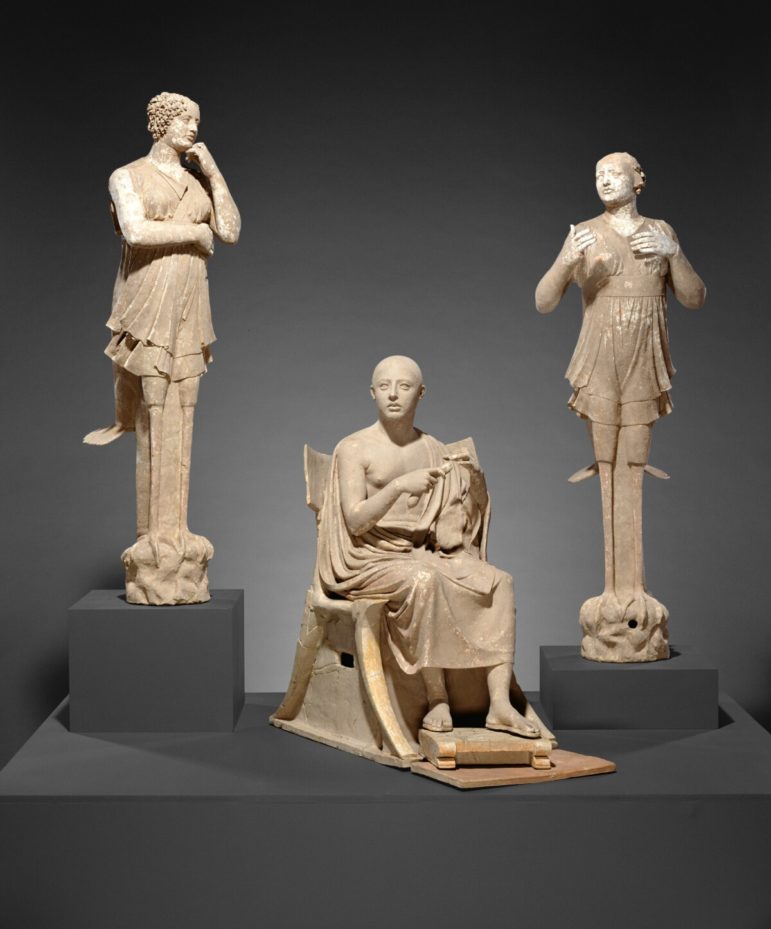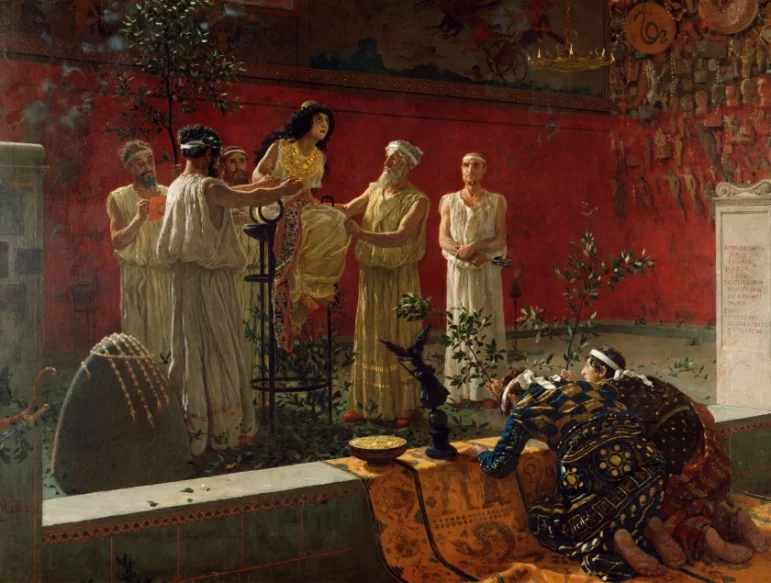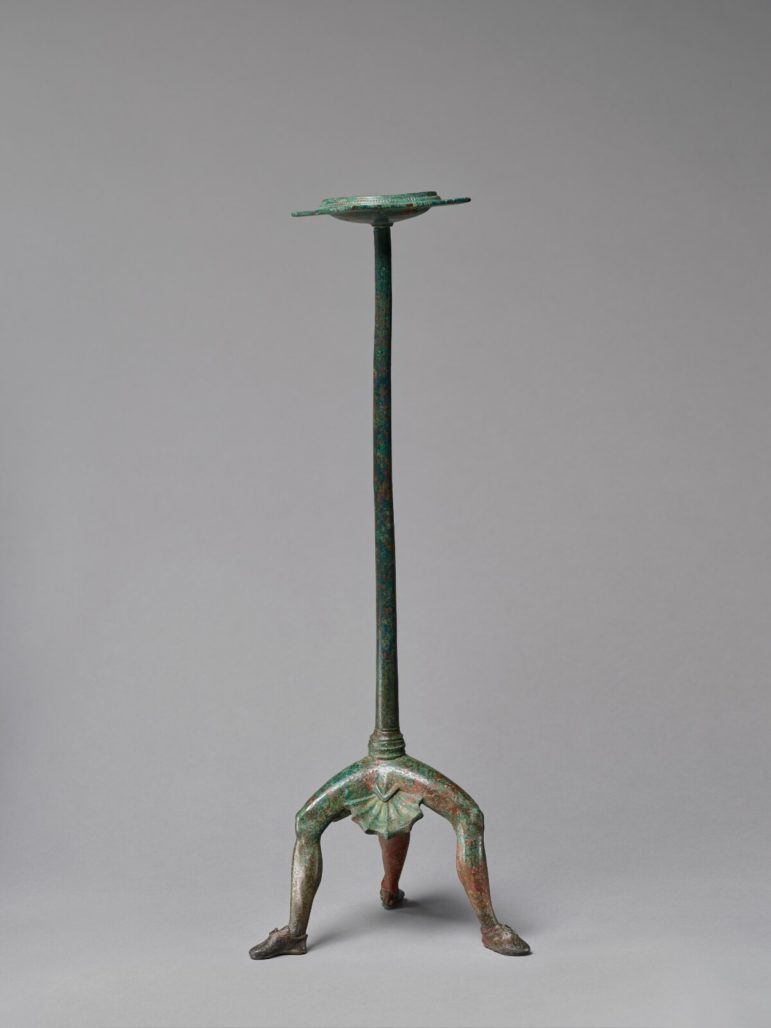
LOS ANGELES – The J. Paul Getty Museum announced this week that it is returning a group of sculptures known collectively as the Sculptural Group of a Seated Poet and Sirens, but better known as Orpheus and the Sirens, that had been illegally excavated and exported from Italy. The museum has withdrawn the objects from public view and will repatriate them. The sculptures have an assessed value of $8 million.
The statues are near-life-size terracotta sculptures of a seated male figure holding a now-missing lyre and two sirens – half-bird half-female figures – in an apparent serenade. The male figure is believed to be Orpheus, the bard, poet, and prophet in Greek mythology whose music immunized the sailors of the Argonaut from succumbing to the sirens’ song. In another story, Orpheus uses his music to convince Hades and Persephone to allow him to return his wife, Eurydice, from the Underworld after she died from a snake bite. He fails from his lack of faith in the words of the gods.

Sculptural Group of a Seated Poet and Sirens (2) with unjoined fragmentary curls (304) and shells (2), 350–300 BC, Greek. Terracotta with white slip of calcium carbonate and polychromy (orange-gold, black, red, gold-yellow, brown, pink). [Courtesy: J. Paul Getty Museum]
The statues were made between 350 B.C.E. and 300 B.C.E. in Tarentum, Italy, and are exceptionally and beautifully preserved. The sculptures still contain traces of polychromy, suggesting they were originally painted in multiple colors. They appear to have been part of a tomb.
J. Paul Getty himself purchased Orpheus and the Sirens in 1976 according to the Getty’s archives. A note from his diary on March 6, 1976, identifies a purchase of “a group of 3 Greek statues made in Tarentum at the end of the 4th C.B.C. They represent a singer Orpheus seated and 2 standing sirens. $550,000 from Bank Leu.”
The sculptures have been a keystone of Getty’s collection and had been on display at the museum on the ground floor of the Getty Villa for more than four decades. “It is a very important work. I’d even say one of the most important in the [Getty Museum’s] collection,” Getty Museum director Timothy Potts said in an interview. “So it will be a loss as to what we can represent about the art of the ancient classical world, in this case southern Italy in the late fourth century B.C.”
The Getty Museum in Los Angeles was notified of the seizure by the Manhattan district attorney’s office, which is well-known for locating stolen art and antiquities. The objects in question are reportedly part of the collection of Gianfranco Becchina, 83, who has been convicted of receiving stolen antiquities by Greece. Italy’s fascinatingly effective art theft police, the Carabinieri TPC or Carabinieri Command for the Protection of Cultural Heritage, identified Becchina as “one of the most prolific known traffickers of Italian cultural heritage, and all property that has been shown to have been illicitly trafficked by Becchina is subject to confiscation.”
Timothy Potts, director of the Getty, said in the release that the museum “determined that these objects should be returned” by working with officials from the Manhattan district attorney’s office.
“It’s just extremely rare and there’s nothing similar in our collection, or closely similar in any collection,” Potts said. “It does leave a hole in our gallery but with this evidence that came forth, there was no question that it needed to be sent back to Italy.”
The repatriation has been several months in the making, even before the April confiscation. Massimo Osanna, the director general for museums for Italy’s culture ministry, said discussions with the Getty over the return of Orpheus and the Sirens had begun last February when museum officials visited Rome. The subsequent seizure order “accelerated the situation,” he said.
Getty is coordinating with Italian authorities. In a press release, Getty wrote that “The extreme fragility of Orpheus and the Sirens requires specially tailored equipment and procedures—an area of expertise in which Getty has extensive experience.”
The objects will arrive in Rome in September and eventually move to a permanent home in Taranto, Puglia, in Italy’s new Museo dell’Arte Salvata, or Museum of Rescued Art, which was inaugurated earlier this summer. The museum is using the term “rescued art” broadly, and it will display art that has been salvaged and recovered in numerous ways, including art that survived not only theft but also shipwrecks and natural disasters. Italy is home to some of the world’s most exceptional restorers, who will work on pieces before they are displayed.
The first exhibition of the Museum of Rescued Art, which runs through mid-October, will focus on looted art, paying tribute to Italy’s Carabinieri TPC.
Italy’s culture minister, Dario Franceschini, said at the inauguration of the museum that it would “show the world the excellence of our work” in all these fields.

The Oracle, 1880, Camillo Miola (1840–1919). Oil on canvas. [Courtesy: Getty Museum]
This is not the first time Getty has returned art to Italian authorities. In 2007, after “complex negotiations,” the museum returned some 40 pieces from the Getty’s antiquities collection to Italian authorities.
More art is still in question, including acquisitions made in 1996 of a colossal marble head of divinity and a mold made from limestone cast for pendants. Both date to the second century CE. Camillo Miola’s painting “The Oracle” and an Etruscan incense burner from the fourth century will also be returned. The objects have never been displayed and are slated for repatriation to Italy at a future date.

Thymiaterion, Etruscan incense burner, c.350–325 BC. Bronze. [Courtesy: Getty Museum]
There is also disagreement over the so-called Getty Bronze, the statue formally known as the Victorious Youth. Italian authorities claim the museum had been negligent in its acquisition of the artwork, but Getty says the connection to Italy is weak because it had been discovered in international waters.
Getty declined to comment further on the investigation leading to the current seizure. “The Getty is not in a position to comment on information that led to the return of the Orpheus,” spokesperson Julie Jaskol told the Los Angeles Times. “The information was supplied by Matthew Bogdanos of the Antiquities Trafficking Unit of the Manhattan district attorney’s office, who developed the evidence in an investigation unrelated to the Getty. The evidence persuaded us that the statues had been illegally excavated and it was appropriate to return them in accordance with Getty policy.”
“We value our strong and fruitful relationship with the Italian Ministry of Culture and with our many archaeological, conservation, curatorial, and other scholarly colleagues throughout Italy,” added Potts, “with whom we share a mission to advance the preservation of ancient cultural heritage.”
The Wild Hunt is not responsible for links to external content.
To join a conversation on this post:
Visit our The Wild Hunt subreddit! Point your favorite browser to https://www.reddit.com/r/The_Wild_Hunt_News/, then click “JOIN”. Make sure to click the bell, too, to be notified of new articles posted to our subreddit.
